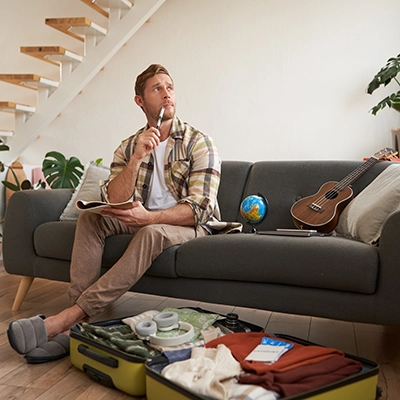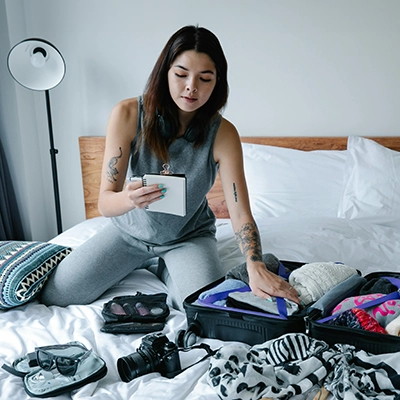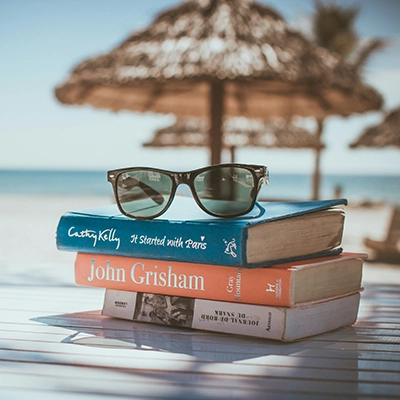I don't know how, but somehow it always happens. My bag fills up when I'm only halfway through packing the pile of stuff I planned to take.
As a location-independent travel writer, I live out of a bag, so I've spent many a late-night hour before a flight wondering what is and isn’t necessary to bring.
Over the last few years, I've taken note of the extraneous things that I'm consistently, and needlessly, hauling around the globe. I’ve found that many commonly packed items aren’t needed because they are easily procured in almost any location with an international airport.
Here's a list of things to consider crossing off your packing list for vacation to make room for more important things or to just travel lighter.
Packing Tips for Travel to Keep You from Overpacking
1. Sunscreen
It's something you need, but not something you need to pack since it's available in most any country where the sun is shining bright enough to burn you. Unless you are picky and want a specific brand of sunscreen, why not just grab it once you land?
If you’re worried about waste, you can always gift it some fair-skinned traveler on the last day of your trip. You’ll be the most popular kid at your hostel.
2. Swimsuit AND athletic shorts
Ladies, feel free to skip this one.
This may blow some minds, but subtract marketing, and swimming trunks and athletic shorts are essentially the same thing. Trunks can leave the pool to run the trails, and there’s nothing athletic shorts love more than a dip in the pool.
Tip from your (lady) editor: Athletic shorts and a sports bra work fine for swimwear in a pinch. We can multipurpose, too, Luke.
3. First-aid kit
While my inner Boy Scout (and the rest of the Seven Corners team) is upset to see me type this, unless you will be adventuring away from civilization, a first-aid kit tends to remain untouched on trips.
To be on the safe side, bring a few band-aids and antiseptic wipes, maybe some antacid and headache medication, but leave the fully loaded kit at home.
If you are going to be off the beaten path or camping, though, don’t skip the kit. And before you leave home, check to make sure it’s fully stocked and in good condition.
4. More than one or two pairs of shoes
Yet another unpopular opinion here, but shoes take up a lot of space. I opt for a good pair of waterproof hiking boots that look stylish enough to pull off evening outings. Because I'm a jogger, I've switched to the Vibram five-finger running shoes, which take up a third of the space as regular sneakers.
Note from your friendly (wet-feet hating) editor: It’s always nice to have a spare pair of shoes — just one will do — for rainy days when you need something else to change into. Few things will give you blisters quicker than walking in damp shoes, and no one wants that.
5. Laptop
If you're traveling for business or are a digital nomad, this hack does not apply to you.
Coming from the guy who earns his living via his laptop, this is an interesting item to include. But on a short trip, it's one more expensive piece of equipment to worry about protecting. Plus, it’s capable of preventing you from getting the most out of your trip by distracting you with email, Facebook, and other social media networks.
Unless you absolutely need it, leave the laptop at home, and be more present during your trip.
6. Too many clothes
Yes, you do need some clothes. I'm not advocating that you become a nudist, but I do suggest you make a pile of clothes to pack and then cut it in half.
Clothes are what everyone always seems to overpack. I’m pretty sure that if you under-pack, you can pick up some new duds at your destination, wherever that might be. These then become souvenirs, as in, "This is my yak jacket I got in Mongolia!"
Editor’s pro-tip, part 1: Take time to learn about the weather at your destination. Don’t waste space on a jacket if there’s going to be a heatwave at your destination while you’re there. And don’t bother with a swimsuit for the ocean if temperatures are going to make the water unbearably cold.
Editor’s pro-tip, part 2: Roll the clothes you do pack. It does actually save space when compared to folding (or, heaven forbid, just jamming them in your duffle). If you’re worried about wrinkles, roll your most wrinkle-proof items on the inside of the bundle and your more delicate items on the outside.
7. Flashlight
Take this one with a grain of salt, especially if you're going to be roughing it in the bush. But if you're traveling on the beaten path, think about how much you use your flashlight at home. That's about how much you'll use it on your trip.
Worst comes to worst, you can buy one for a few bucks at your destination and give it to a grateful kid before you leave.
Another note from your favorite editor: In a pinch, you can use the flashlight on your phone instead. This isn’t a great option for camping, but it will work in most other situations.
8. Toiletries
Bring your toiletries, but if you're overpacked and need to make space, or you're packing carry-on only, you might be able to leave most of your toiletries at home.
All you really need is a toothbrush and small tube of toothpaste to keep that breath fresh while in transit. Everything else you can get when you get there and leave behind upon your return.
It’s that editor again: You might also be able to save space by reconsidering what kind of toiletries you need. Bar shampoo, for example, takes up less space than a bottle and is easier to get through airport security in a carry-on since it isn’t a liquid.
9. Multiple books
This is one of the packing tips for international travel I’ve learned the hard way, and I'm likely the worst offender in the world on this one. I just flew from Japan to the U.S. with six books in my bag. Even after I purchased a Kindle, I still tend to have way too many books with me. Once I carried a 1,200-page novel from Chile to Colombia without opening it.
It's easy to assume that you will have plenty of time to read on a trip, but in reality, you will likely be doing more than reading. If you run out of reading materials, English-language books can often be found easily around the globe. Leaving it to chance will introduce you to books you might never have otherwise picked up.
10. Travel guidebook
Travel guidebooks are great resources, but I recommend reading them ahead of time and bringing notes instead of the bulky guidebook. They not only take up space, but they limit your experience to what one guidebook writer has found.
As a travel writer, I'm a believer that people should carve their own path rather than following someone else's exactly. The best travel guides are the ones that walk on two legs — the people you befriend when you get there.
Travel Insurance for Lost and Delayed Luggage
Traveling light has tons of advantages. If you can get everything in a carry-on bag, even better. Delayed or lost baggage is not all that uncommon, and the fewer pieces of luggage you have, the better the odds are that you’ll arrive at your destination with all of your belongings.
For those times when you show up and your baggage doesn’t, travel insurance might be able to help. Your coverage can reimburse you to replace the essentials if your loss meets the requirements outlined in your plan. That means you can get on with the rest of your trip without losing money on clothes or toiletries you hadn’t planned to buy on the road.
Learn about the other benefits of a trip protection plan and get a quick quote at SevenCorners.com.
About the Authors
Luke Maguire Armstrong has hauled luggage — sometimes more than he’s needed — to more than 30 countries in the course of his travel writing career. He frequently shares his travel tips on the Seven Corners blog.
Becky Hart was your friendly, clothes-rolling, dry-shoe loving, multi-purpose swimwear-wearing lady editor for this article.



